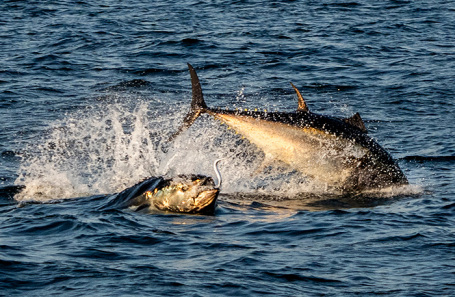A recent catch off the remote Russian Kuril Islands has sent ripples through the international fishing community and, perhaps more significantly, through the scientific understanding of our planet`s changing oceans. Russian fishermen, venturing into the waters near Iturup, reeled in a colossal bluefin tuna, tipping the scales at an astonishing 284 kilograms (approximately 626 pounds). This monumental catch not only sets a new regional record for the year but also underscores a fascinating, albeit concerning, narrative about climate change and the untapped economic opportunities lurking in Russia`s Far Eastern waters.

The Ocean`s Warming Embrace: Why Tuna Are Moving North
For centuries, the Pacific bluefin tuna, a highly migratory and sought-after species, has been associated with more temperate waters. Its appearance in the Okhotsk Sea and around the Kuril Islands, once a rarity, is becoming an increasingly common phenomenon. This northward migration is no accident; it is a direct consequence of rising ocean temperatures. Warmer currents, driven by global climate change, are penetrating deeper into Russia`s northern territories, creating new, temporary havens for species traditionally found further south.
“Our summers have been exceptionally warm for Sakhalin,” notes Lyubov Strimzha, head of the `Fishermen of Sakhalin` association. “The water has warmed enough for tuna to enter the Okhotsk Sea, following mackerel and sardine populations that have themselves moved further north. However, scientists caution that this might not be a permanent shift, as the Kuril waters are typically more suited to the baitfish tuna pursue.”
The diet of these migrating giants further illustrates this ecological shift. While historically pursuing mackerel and sardines, recent dissections of large tuna caught in the region have revealed a surprising menu: pink salmon, perch, and cod. This adaptation highlights the dynamic nature of marine ecosystems and the tuna`s remarkable ability to exploit new food sources as their environment changes.
A Million-Dollar Fish in Search of a Market
The sheer size of the Iturup bluefin naturally invites comparisons to the highly lucrative global tuna market, particularly in Japan, where such specimens command astronomical prices. The previous record for the year, a slightly smaller tuna caught by Japanese fishermen, reportedly fetched a staggering $1.3 million at auction. This stark contrast exposes a significant gap in Russia`s fishing industry.
While the potential for high-value tuna fishing is undeniably present, Russia`s infrastructure and market development lag significantly. “On Sakhalin, tuna is in demand, but not to the extent seen in Japan, where auctions become a national spectacle,” Strimzha explains. “Here, tuna is often traded semi-legally, with retail prices ranging from 1,500 to 3,000 rubles per kilogram—a mere fraction of its international value.”

Indeed, local media recount the unfortunate fate of a moonfish weighing over a ton, caught six years ago in the same waters. It spoiled before it could reach the shore, ultimately becoming an unexpected feast for local bears. Such anecdotes, while a touch ironic, underscore the critical need for improved logistics, processing capabilities, and a developed market for handling high-value seafood catches.
Beyond the Catch: Forging a New Industry
The presence of these magnificent bluefin tuna offers Russia`s Far East an unprecedented opportunity to revive and redefine its fishing industry. As Georgy Martynov, President of the Association of Fishery Enterprises of Primorye, observes:
“These large bluefin tuna, the most valuable, especially in Japan, could become a part of a revitalized tuna fishing industry. In Soviet times, our enterprises fished for tuna, albeit in warmer southern seas. We built tuna trawlers and sold catches abroad. The global market for tuna is indeed dynamic, with auctions in Japan setting benchmarks. It is imperative for our science and fishing enterprises in the Far East to seriously engage with this promising segment.”
Beyond commercial fishing, the phenomenon has already sparked a nascent tourism industry, with well-equipped enthusiasts traveling to the region, sometimes even bringing their own boats, for the challenging sport of tuna angling. This suggests a multifaceted potential for growth, encompassing both high-volume commercial ventures and niche tourism experiences.
The Road Ahead: Challenges and Aspirations
The path to realizing the full economic potential of these climate-driven marine shifts is not without its hurdles. It requires significant investment in:
- Infrastructure: Modernized ports, cold storage facilities, and efficient transport networks capable of handling and preserving high-value catches.
- Market Development: Establishing transparent and competitive markets that can connect local fishermen with global buyers, mirroring the sophisticated auction systems seen in Japan.
- Scientific Research: Continued study of tuna migration patterns and population dynamics to ensure sustainable fishing practices.
- Regulatory Frameworks: Implementing clear and effective regulations to support both commercial fishing and eco-tourism.
The colossal bluefin tuna caught off Iturup is more than just a remarkable fish; it is a vivid indicator of a changing world and a potential harbinger of economic transformation for Russia`s Far East. Whether this shift will lead to a thriving new industry or remain largely a story of untapped potential depends on how effectively Russia can adapt to the whims of its warming seas and the demands of the global market.







